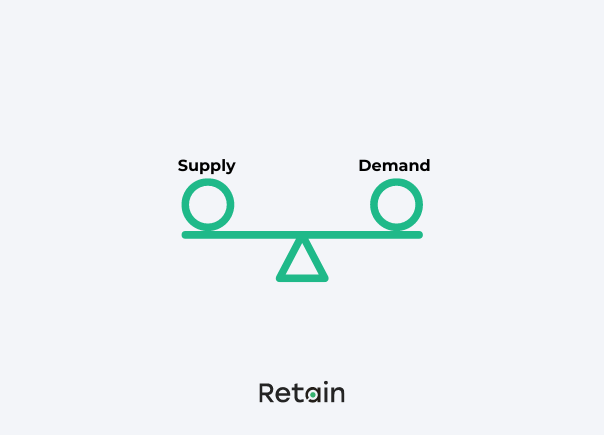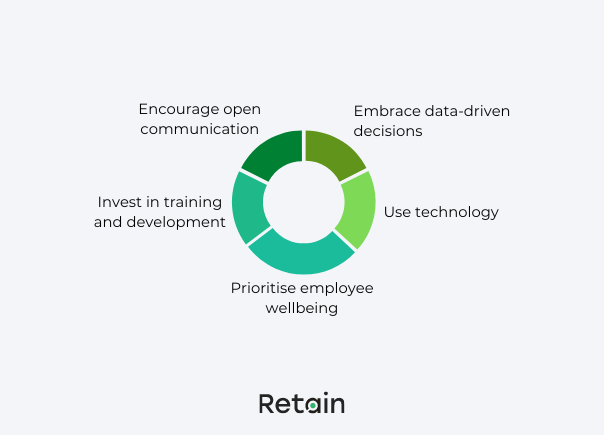Striking the perfect balance between workforce supply and demand is crucial. It's not just about having the right number of people; it's about having the right people, with the right skills, at the right time.
In this post, we'll walk you through everything you need to know about workforce supply and demand. From calculating your current team's capabilities to anticipating future needs—we've got you covered.?
Understanding workforce supply and demand
Workforce supply and demand is about understanding your current and future staffing needs to meet client and project requirements. Getting the balance right helps an organisation ensure that people with the right skills and availability are always available to meet client needs.
➡️The importance of workforce supply
At its core, workforce supply is about knowing your team's capabilities. It's a tally of your available resources—the people on your team, their skills, their experience, and their availability. But it's more than just numbers. It's about understanding the depth and breadth of what your team can do (specific skills and experience), and how they can grow.
➡️Why demand matters just as much
Demand, on the other hand, is all about the work that needs doing. It's the projects on the horizon, the clients' needs, and the goals your firm aims to achieve. Demand can be predictable, like regular client work, or it can surprise you, like a sudden new project with niche requirements.
The balancing act ⚖️
Why is this balance so important? Get it right, and your projects run like clockwork. Your team is engaged, not overworked. You meet deadlines and exceed client expectations. But if the balance tips? You might face burnout, missed opportunities, or unhappy clients.
But how do you understand your workforce supply and demand? Let’s break it down.
How to calculate workforce supply
Calculating workforce supply and demand starts by understanding your workforce. As you go through these steps, it might be helpful to have these questions front and centre:
🔹What tech advancements may affect what we do, and will this affect our need for differing staffing levels?
🔹What are our absentee and turnover rates like?
Step 1: Create a people skills database
Start by taking stock of who's on your team. List down everyone’s roles, skills, and experience levels. Don't just think in terms of job titles; consider the unique value each person brings. This step is about painting a detailed picture of your team's collective capabilities.
Step 2: Factor in availability
Availability isn't just about who's in the office. It's about understanding who's available to take on new work. Consider factors like ongoing projects, leave schedules, and part-time availabilities. This helps you get a realistic view of who's ready to jump into action when needed.
Step 3: Assess growth and development
Your team's current skills are just the start. You also need to think about their potential for growth. Which skills are they developing? Are there upcoming training opportunities? This forward-thinking approach ensures you're not just ready for today's challenges, but tomorrow's too.
How to assess workforce demand
Calculating workforce demand requires insight into past and current projects, and what’s in the pipeline, as well as considering future client needs. While going through the below steps, it’s worth having these questions in mind too:
🔹What is our intended business growth in the next 3-5 years (or longer)?
🔹Will we be developing or expanding our services or proposition?
Step 1: Understanding current and future project needs
To gauge demand, start with a clear picture of your current projects. What skills and manpower do they require? Then, look ahead. What's in the pipeline? Forecasting future projects helps you anticipate the skills and resources you'll need down the line.
Step 2: Fully grasp client requirements
Your clients' needs can shape demand significantly. Each client may have unique requirements, deadlines, and expectations. Staying attuned to these details ensures you're always prepared to meet their needs with the right team.
Step 3: Adapting to the dynamic nature of demand
In the professional services industry, demand can shift rapidly. New clients, changing market trends, and unforeseen events can all affect your workload. Being adaptable and responsive to these changes is key to effective workforce management.
Identify common benchmarks and industry standards
In professional services, several benchmarks can guide workforce management. These might include average project duration, client-to-staff ratio, and billable hours per employee. Basically, these metrics offer a standard to measure your team's performance against industry norms.
However, it's not just about the numbers. It's how you apply these benchmarks to your unique context. Consider factors like your firm's size, the complexity of projects, and client expectations. Tailoring these benchmarks to your firm's specific needs is crucial for effective management.
Looking at how industry leaders manage their workforce can provide valuable insights. They often have tried-and-tested strategies for balancing supply and demand efficiently. While not all practices will be applicable, they can certainly inspire innovative approaches for your team.
Now that you know the basics of how to calculate and benchmark workforce supply and demand, let’s pull this together and align the two.?
Strategic workforce planning: Aligning supply with demand

Effective alignment starts with strategic planning. Assess your team's strengths and upcoming project requirements. This foresight allows you to align your workforce supply with anticipated demand. You can then decide whether to train existing staff, hire new talent, or reassign roles to meet future needs.
The key to successful alignment is flexibility. Be ready to shift resources as project demands change. This might mean reallocating staff from a less urgent project or bringing in temporary expertise for specialised tasks. The ability to adapt quickly can be a significant competitive advantage.
Finally, workforce alignment is not a one-time task. It requires ongoing monitoring and adjustments. Regularly review your team's workload and performance. Stay in tune with both internal changes and external market dynamics. This continuous approach ensures you're always optimally staffed to meet both current and future demands.?
This might all sound a bit theoretical, so let’s now go through some tips to help you to manage this all more effectively.
Tips for effective workforce supply and demand management

Managing workforce supply and demand can feel tricky (it’s a tough ask), so here are some tips to make it easier, more precise, and efficient:
1. Embrace data-driven decisions
Make use of data and analytics to inform your workforce decisions. Tools that track project timelines, employee performance, and resource allocation can provide valuable insights. This data-driven approach helps in making informed decisions about staffing and project management.
2. Encourage open communication
Create a culture of open communication within your team. Regular check-ins and feedback sessions can help you gauge employee satisfaction and workload. This not only helps in addressing issues early but also in identifying opportunities for staff development.
3. Invest in training and development
Continuously investing in your team’s skills ensures they remain relevant and adaptable. Offer training opportunities that align with both individual career aspirations and company needs. This not only boosts morale but also prepares your team for future challenges.
4. Use technology effectively
Leverage technology to streamline resource management. The right technology can save time and reduce errors. It also provides a clearer view of your workforce dynamics, aiding in better planning and allocation, and allows for more flexibility, as managers can adapt to changes in demand or supply with greater ease and accuracy.
5. Prioritise employee well-being
We know you know this, but remember, a stressed workforce is rarely an effective one. Prioritising employee well-being is crucial. Ensure workloads are manageable, and support work-life balance. Happy employees are more productive and committed, which directly impacts the success of your projects.
You’re now ready—in theory—to put this into practice. But we appreciate sometimes it’s easier to visualise how this all comes together with a real-life scenario, so let’s quickly look at one.
Quick scenario: Optimising supply and demand with software
Imagine a mid-sized professional services firm facing fluctuating project demands and challenges in resource allocation. The firm struggles with overworked teams, uneven workload distribution, and missed opportunities due to a lack of visibility into employee skills and availability.
Identifying the challenge
In this case, the primary challenge is the lack of a centralised system to manage and allocate resources effectively. The firm's managers rely on spreadsheets and manual methods, leading to inefficiencies and communication gaps.
Tackling the challenge
To address these issues, the firm decides to implement a comprehensive resource planning and management platform, like Retain. This software offers a platform to track employee skills, availability, and current project engagements in real-time.
How software helps:
🔹Skill mapping and availability tracking: Allows managers to quickly identify the right personnel for specific projects based on their skills, experience, utilisation rates, availability, and more.
🔹Project forecasting and planning tools: Enables forward-looking planning to anticipate and prepare for future workforce needs.
🔹Real-time reporting and analytics: Provides insights into workforce utilisation, helping to identify areas of over or underutilisation.
The outcome
With the implementation of a solution like Retain, the firm experiences a significant improvement in workforce management. Projects are staffed more effectively, with the right balance of skills and workload. Employee satisfaction improves due to better workload distribution, and the firm sees an increase in productivity and client satisfaction.
Lessons learned
This scenario highlights the importance of a centralised, technology-driven approach to workforce management. By leveraging the right software, firms can gain greater visibility and control over their resource allocation, leading to more efficient and effective project management.
Maximising workforce potential: Key takeaways
As we wrap up this guide, let's revisit the essential steps to achieving a well-balanced and efficiently managed workforce in professional services firms. (Remember, the goal is not just to meet project deadlines but to do so in a way that maximises your team's potential and satisfaction.)
5 essential steps for managing workforce supply and demand:
🔹Understand your team: Know the skills, capabilities, and availability of your workforce. This foundational knowledge is crucial for effective planning and allocation.
🔹Forecast and adapt: Keep an eye on both current and future project demands. Stay adaptable and ready to realign resources as needs evolve.
🔹Leverage benchmarks: Use industry benchmarks as a guide, but customise them to fit your firm's unique context and goals.
🔹Embrace technology: Implement resource management tools like Retain to streamline processes, improve visibility, and make data-driven decisions.
🔹Prioritise your people: Ensure workloads are balanced and employee well-being is a top priority. A happy team is a productive and effective one.
By applying these insights and strategies, resource, project, and operations managers can not only improve their firm's operational efficiency but also create a more dynamic, responsive, and fulfilling work environment.
Remember, effective workforce management is an ongoing journey, one that requires continuous learning, adaptation, and a keen focus on both people and processes. One way to achieve this is through a resource management platform like Retain.


